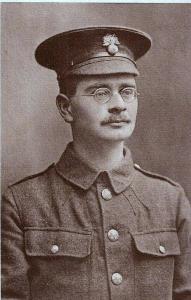
|

|
| Private Alban Reginald STRICKLAND (231104) | |
|
2/2nd (City of London) Battalion (Royal Fusiliers) Date of birth: 18th March 1891 Date of death: 26th October 1917 Killed in action aged 26 Commemorated on the Tyne Cot Memorial Panels 148 to 150 |

|
| Alban Reginald Strickland was born at Surbiton in Surrey on the 18th of March 1891 the second son of Robert Strickland, a banker, and Mary Katherine (nee Sharpe) Strickland of Elm Lodge, Surbiton later of "Fairstead", Gerrards Cross in Buckinghamshire. He was christened at St Mark’s Church, Surbiton on the 16th of April 1891. He was educated at Mr. Sylvester’s School at Godalming in Surrey and at Lancing College where won an Exhibition and was in Olds House from September 1902 to July 1909. On leaving school he spent some time in Canada returning home on board the SS “Empress of Britain” on the 30th of September 1910. In October 1910 he entered Keble College Oxford where he achieved a BA in 1914. He was a member of the Oxford University Officer Training Corps. On leaving university he became an assistant prep school master in Carlisle before enlisting in the London Regiment as Private 3377. On the night of the 24th/25th of October 1917 the 2/2nd (City of London) Battalion (Royal Fusiliers), under the command of Major Miller, moved into the front line near Poelcappelle for an attack to made on the 26th. Conditions underfoot were described as appalling and due to the lack of clear tracks it was daybreak before the bulk of the battalion was in position. Their objective was the German first line from Spider Cross Roads to an enemy blockhouse known as Moray House. Once they had captured this, the first objective of the attack, the 2/4th Battalion London Regiment would leapfrog them and move onto the second and final objective, being a line astride the Poelcappelle/Westroosebeeke Road. The assembly of the battalion for the attack took some nine hours during which time the men spent long period lying in flooded trenches and shell holes before they reached the start line at 1.15am. Major Miller, in command of the battalion that night recorded in his diary:- "The 2/2nds are ready to kill as many Boche as possible, and we are all happy to think of the possibility of doing a bit of slaughter." At 3am the weather broke and the driving rain would continue for the next 24 hours. During this time the enemy shelled the battalion positions continuously causing heavy casualties particularly in A Company who lost an officer and every NCO before morning. Included in the battalion's objectives was a group of blockhouses known as Cameron Houses, a blockhouse to the east of Tracas Farm and Moray House itself. At 5.30am the battalion surged out of their trenches, soaked to the skin and with their rifles clogged with mud. The "creeping" barrage to be laid down in support by the British artillery proved to be very weak and as a result the German machine gunners were able to take a heavy toll of the Londons as they laboured through the thick mud towards the German lines. German artillery also joined in and within three minutes of the start of their advance the Londons were blanketed in explosions and thick smoke. Men took shelter in shell holes but many simply sank into the mud and were not seen again. Incredibly the blockhouse at Tracas Farm was taken along with thirty two prisoners. Likewise a party from A Company under Captain Harper captured five of the six blockhouses at Cameron Houses. At 7.20am the Germans counterattacked, forcing back the neighbouring battalion, and exposing the flank of the hard pressed Londons. Cameron Houses was retaken and, at between 4pm and 5pm,another attack was pressed against Tracas Farm but this gain was held by the Londons at terrible cost. Casualties for this action were 3 officers and 36 other ranks killed, 3 officer and 190 other ranks wounded with 2 officers and 152 other ranks posted as missing. He is commemorated on the war memorial at Chalfont St Peter in Buckinghamshire and on the memorial at Keble College Oxford. |
|
| Olds House |
Back